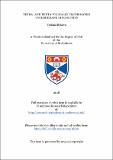Tetra- and penta-vicinally fluorinated cyclohexane ring motifs
Abstract
Organofluorine compounds have had an important influence on the advances in the
healthcare and agricultural industries. Selective substitution with fluorine can produce a
significant impact on the pharmacokinetic properties of bioactive compounds; generally this
is through stereoelectronic effects that the fluorine atom can confer. As such, there is a
continuous interest in the development of novel organofluorine compounds and the
incorporation of fluorine into bioactive compounds and natural products.
The all-cis-1,2,4,5-tetrafluorocyclohexane motifs were the first examples of facially polarised
cyclohexane rings which possess a dipolar nature arising from two 1,3-diaxial C-F bonds. The
fluorine face, which possesses a negative electrostatic profile, along with the positively
polarized methylene hydrogens on the opposite face give a unique facial polarity to this
motif.
These highly polarized fluorinated ring systems present as novel building blocks for use in
drug development and agricultural programs; hence the aim of this study was the
development of functionalised derivatives of these all-cis tetrafluoro-cyclohexanes.
Transformations of previously reported phenyl all-cis-2, 3, 5, 6-tetrafluoro-cyclohexane were
explored in a variety of directions and new pathways towards partially fluorinated
cyclohexanes were investigated. The range of all-cis-tetrafluorocyclohexane motifs
produced, with functional groups attached directly to the fluorinated cyclohexane ring,
varied from methyl substituted all-cis-tetrafluorocyclohexane alcohols, aldehydes, nitriles
and amines to all-cis-tetrafluorocyclohexane amino acid, pentafluoro carboxylic acid and
alcohol derivatives.
These novel derivatives were then used in liquid-phase peptide synthesis, incorporated into
peptidomimetic systems through Ugi multi-component reactions and utilised in the
formation of bis-systems, in order to demonstrate their reactivity and to gain an insight into
their possible intramolecular conformational preferences and supramolecular
arrangements.
Type
Thesis, PhD Doctor of Philosophy
Collections
Items in the St Andrews Research Repository are protected by copyright, with all rights reserved, unless otherwise indicated.

